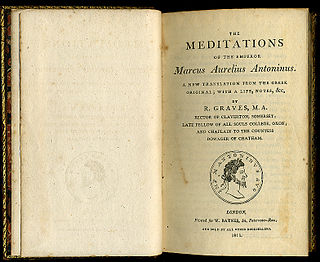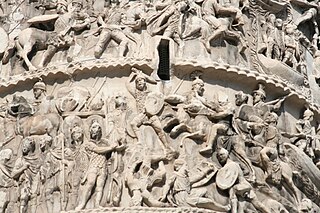The Arch of Marcus Aurelius may refer to:
- Arch of Marcus Aurelius (Rome), in Italy
- Arch of Marcus Aurelius (Tripoli), in Libya (ancient city of Oea)
The Arch of Marcus Aurelius may refer to:

Marcus Aurelius Antoninus was Roman emperor from 161 to 180 AD and a Stoic philosopher. He was the last of the rulers known, noncontemporaneously, as the Five Good Emperors and the last emperor of the Pax Romana, an age of relative peace, calmness and stability for the Roman Empire lasting from 27 BC to 180 AD. He served as Roman consul in 140, 145, and 161.

Lucius Aurelius Verus was Roman emperor from 161 until his death in 169, alongside his adoptive brother Marcus Aurelius. He was a member of the Nerva-Antonine dynasty. Verus' succession together with Marcus Aurelius marked the first time that the Roman Empire was ruled by more than one emperor simultaneously, an increasingly common occurrence in the later history of the Empire.

Oea was an ancient city in present-day Tripoli, Libya. It was founded by the Phoenicians in the 7th century BC and later became a Roman–Berber colony. As part of the Roman Africa Nova province, Oea and surrounding Tripolitania were prosperous. It reached its height in the 2nd and 3rd centuries AD, when the city experienced a golden age under the Severan dynasty in nearby Leptis Magna. The city was conquered by the Rashidun Caliphate with the spread of Islam in the 7th century and came to be known as Tripoli during the 9th century.
Faustina may refer to:

The Arch of Constantine is a triumphal arch in Rome dedicated to the emperor Constantine the Great. The arch was commissioned by the Roman Senate to commemorate Constantine's victory over Maxentius at the Battle of Milvian Bridge in AD 312. Situated between the Colosseum and the Palatine Hill, the arch spans the Via Triumphalis, the route taken by victorious military leaders when they entered the city in a triumphal procession. Dedicated in 315, it is the largest Roman triumphal arch, with overall dimensions of 21 m (69 ft) high, 25.9 m (85 ft) wide and 7.4 m (24 ft) deep. It has three bays, the central one being 11.5 m (38 ft) high and 6.5 m (21 ft) wide and the laterals 7.4 m (24 ft) by 3.4 m (11 ft) each. The arch is constructed of brick-faced concrete covered in marble.
Verus may refer to:

The Equestrian Statue of Marcus Aurelius is an ancient Roman equestrian statue on the Capitoline Hill, Rome, Italy. It is made of bronze and stands 4.24 m tall. Although the emperor is mounted, the sculpture otherwise exhibits many similarities to standing statues of Augustus. The original is on display in the Capitoline Museums, with the sculpture now standing in the open air at the Piazza del Campidoglio being a replica made in 1981 when the original was taken down for restoration.

Meditations is a series of personal writings by Marcus Aurelius, Roman Emperor from AD 161 to 180, recording his private notes to himself and ideas on Stoic philosophy.

The Nerva–Antonine dynasty comprised seven Roman emperors who ruled from 96 to 192 AD: Nerva (96–98), Trajan (98–117), Hadrian (117–138), Antoninus Pius (138–161), Marcus Aurelius (161–180), Lucius Verus (161–169), and Commodus (180–192). The first five of these are commonly known as the "Five Good Emperors".

The Marcomannic Wars were a series of wars lasting from about 166 until 180 AD. These wars pitted the Roman Empire against, principally, the Germanic Marcomanni and Quadi and the Sarmatian Iazyges; there were related conflicts with several other Germanic, Sarmatian and Gothic peoples along both sides of the whole length of the Roman Empire's northeastern European border, the river Danube.

The Column of Marcus Aurelius is a Roman victory column in Piazza Colonna, Rome, Italy. It is a Doric column featuring a spiral relief: it was built in honour of Roman emperor Marcus Aurelius and modeled on Trajan's Column.
Marcus Antoninus may refer to:

The early life of Marcus Aurelius spans the time from his birth on 26 April 121 until his accession as Roman emperor on 8 March 161.
The Roman–Parthian War of 161–166 was fought between the Roman and Parthian Empires over Armenia and Upper Mesopotamia. It concluded in 166 after the Romans made successful campaigns into Lower Mesopotamia and Media and sacked Ctesiphon, the Parthian capital.
Aurelius may refer to:

The Arch of Marcus Aurelius is a Roman triumphal arch in the city of Oea, modern Tripoli, Libya, where it is found near the northeastern entrance to the Medina.
Marcus Aurelius was a name used by men from the Roman Empire and afterwards. The earliest so called was the emperor Marcus Aurelius. It became widely spread following the Constitutio Antoniniana issued by emperor Caracalla in 212.
Marcus Annius Verus may refer to:

The Arch of Marcus Aurelius was a Roman triumphal arch in Rome, probably in the region of the Campus Martius, near the modern Piazza Colonna and the Column of Marcus Aurelius.